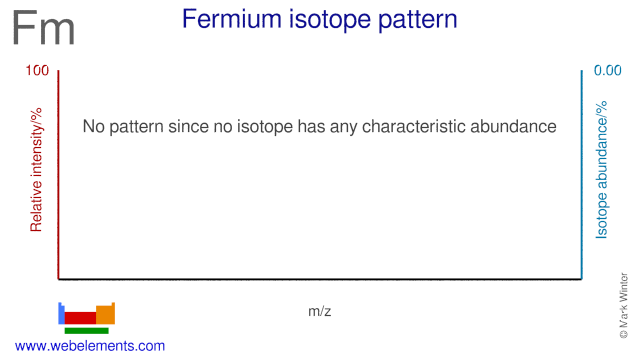Fermium - 100Fm: the essentials
- Name: fermium
- Symbol: Fm
- Atomic number: 100
- Relative atomic mass (Ar): [ 257 ] (longest lived isotope)
- Standard state: presumably a solid at 298 K
- Appearance: unknown, but probably metallic and silvery white or grey in appearance
- Classification: Metallic
- Group in periodic table:
- Group name: Actinoid
- Period in periodic table: 7 (actinoid)
- Block in periodic table: f
- Shell structure: 2.8.18.32.30.8.2
- CAS Registry: 7440-72-4
Fermium atoms have 100 electrons and the shell structure is 2.8.18.32.30.8.2. The ground state electronic configuration of neutral fermium is [Rn].5f12.7s2 and the term symbol of fermium is 3H6.
Fermium: description
Fermium's chemical properties are largely unknown. Fermium is a radioactive rare earth metal. The longest living isotope is is 257Fm with a half-life of 80 days. It is of no commercial importance.
Fermium: physical properties
Density of solid: (no data) kg m-3
Molar volume: (no data) cm3
Thermal conductivity: 10 (estimate) W m‑1 K‑1
Fermium: heat properties
Melting point: about 1800 [1527 °C (2781 °F)] K
Boiling point: (no data) K
Enthalpy of fusion: 20.5 kJ mol-1
Fermium: atom sizes
Atomic radius (empirical): (no data) pm
Molecular single bond covalent radius: 167 (coordination number 3) ppm
van der Waals radius: (no data) ppm
Fermium: electronegativities
Pauling electronegativity: 1.3 (Pauling units)
Allred Rochow electronegativity: 1.2 (Pauling units)
Mulliken-Jaffe electronegativity: (no data)
Fermium: orbital properties
First ionisation energy: 627 (inferred) kJ mol‑1
Second ionisation energy: 1200 kJ mol‑1
Third ionisation energy: 2240 kJ mol‑1
Fermium: abundances
Universe: (no data) ppb by weight
Crustal rocks: (no data) ppb by weight
Human: (no data) ppb by weight
Fermium: crystal structure

Fermium: biological data
Human abundance by weight: (no data) ppb by weight
Fermium has no biological role.
Fermium: uses
Fermium: reactions
Reactions of fermium as the element with air, water, halogens, acids, and bases where known.
Fermium: binary compounds
Binary compounds with halogens (known as halides), oxygen (known as oxides), hydrogen (known as hydrides), and other compounds of fermium where known.
Fermium: compound properties
Bond strengths; lattice energies of fermium halides, hydrides, oxides (where known); and reduction potentials where known.
Fermium: history
Fermium was discovered by Workers at Argonne, Los Alamos, USA, and the University of California at Berkeley, USA. in 1952 at USA. Origin of name: named after "Enrico Fermi".Fermium: isotopes

Fermium: isolation
Isolation: coming soon!
